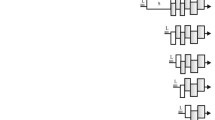Abstract
The origins of DNA replication of the genome (209 kbp) of Chilo iridescent virus (CIV), which is circularly permuted and terminally redundant, were identified. The defined genomic library of CIV, which represents 100% of DNA sequences of the viral genome (e.g., all 32EcoRI CIV DNA fragments), was used for transfection ofChoristoneura fumiferana insect cell cultures (CF-124) that were previously infected with CIV. The plasmid rescue experiments were carried out to select those recombinant plasmids that were amplified during viral replication in CIV-infected cell cultures. It was found that six recombinant plasmids harboring theEcoRI DNA fragments C [13.5 kbp, 0.909-0.974 map units (m.u.)], H (9.8 kbp, 0.535–0.582 m.u.), M (7.25 kbp, 0.310–0.345 m.u.), O (6.5 kbp, 0.196–0.228 m.u.), Q (5.9 kbp, 0.603–0.631 m.u.), and Y (2.0 kbp, 0.381–0.391 m.u.) were able to be amplified under the conditions used. This indicates that the CIV genome possesses six DNA replication origins. Subclones of theEcoRI CIV DNA fragments C and H were screened under the same conditions. It was found that DNA sequences within theEcoRI DNA fragments C and H at the genome coordinates 0.924–0.930 and 0.535–0.548, respectively, contain origins of viral DNA replication. The DNA nucleotide sequences of theEcoRI CIV DNA fragment Y (1986 bp) were determined for identifying the DNA sequence of the corresponding origin of DNA replication. The computer-aided analysis revealed the presence of a 15-mer inverted repeat at nucleotide positions 661–675 and 677–691 (661-TAAATTTAATGAGAA-G-TTCTCATTAAATTTA-692). The analysis of the DNA sequence of theEcoRI DNA fragment H corresponding to the particular region at the genome coordinates 0.535–0.548 (1) showed that this region contains a 16-mer inverted repeat at the nucleotide positions 1315 and 1332 (1315-TAAATTTTAATGGTTA-A-TAACCATTAAAATTTA-1347), which is very similar to the inverted repetition found within theEcoRI DNA fragment Y. The successful recognition and amplification of the single-stranded synthetic DNA sequences of both strands of CIV-ori-Y (nucleotide position 661–691) using phage M13 system in CIV-infected cells is strong evidence that the CIV-ori-Y is bidirectionally active, and this DNA sequence is considered to be the origin of DNA replication within theEcoRI CIV DNA fragment Y.
Similar content being viewed by others
References
Fischer M., Schnitzler P., Delius H., and Darai G., Virology167, 485–496, 1988a.
Delius H., Darai G., and Flügel R.M., J Virol49, 609–614, 1985.
Schnitzler P., Soltau J.B., Fischer M., Reisner H., Scholz J., Delius H., and Darai G., Virology160, 66–74, 1987.
Soltau J.B., Fischer M., Schnitzler P., Scholz J., and Darai, G., J Gen Virol68, 2717–2722, 1987.
Fischer M., Schnitzler P., Delius H., Rösen-Wolff A., and Darai G., in Darai, G., (ed).Molecular Biology of Iirdoviruses. Kluwer Academic Publishers, Boston, 1990, pp. 47–80.
Ward V.K. and Kalmakoff J., Virology160, 507–510, 1987.
Goorha R. and Murti K.G., Proc Natl Acad Sci USA79, 248–252, 1982.
Darai G., Anders K., Koch H.G., Delius H., Gelderblom H., Samalecos C., and Flügel R.M., Virology126, 466–479, 1983.
Darai G., Delius H., Clarke J., Apfel H., Schnitzler P., and Flügel R.M., Virology146, 292–301. 1985.
Fischer M., Schnitzler P., Scholz J., Rösen-Wolff A., Delius H., and Darai G., Virology167, 497–506, 1988b.
Zimmermann U., Trends Biotech 1(5), 149–195, 1983.
Grosveld F.G., Dahl H.M., de Boer E., and Flavell R.A., Gene13, 227–237, 1981.
Ish-Horowicz D. and Burke J.F., Nucleic Acids Res9, 2989–2998, 1981.
Stenlund A., Perricaudet M., Tiollais P., and Petterson U., Gene10, 47–52, 1980.
Cohen S.N., Chang A.C.Y., and Hsu C.L., Proc Natl Acad Sci USA69, 2110–2114, 1982.
Yanisch-Perron C., Vieira J., and Messing J., Gene33, 103–119, 1985.
Lonsdale D., Lancet8121(1), 849–851, 1979.
Sharp P.A., Sugden B., and Sambrook J., Biochemistry12, 3055–3061, 1973.
Southern E.M., J Mol Biol98, 503, 1975.
Rigby P.W.J., Dieckman M., Rhodes C., and Berg P., J Mol Biol114, 237–256, 1977.
Sanger F., Nicklen S., and Coulson A.R., Proc Natl Acad Sci USA74, 5463–5467, 1977.
Sanger F. and Coulson A.R., FEBS Lett87, 107–110, 1978.
Vieira J. and Messing J., Gene19, 259–268, 1982.
Tabor S. and Richardson C.C., Proc Natl Acad Sci USA74, 4767–4771, 1987.
Stow N.D. and McMonagle E.C., Virology130, 427–438, 1983.
Author information
Authors and Affiliations
Rights and permissions
About this article
Cite this article
Handermann, M., Schnitzler, P., Rösen-Wolff, A. et al. Identification and mapping of origins of DNA replication within the DNA sequences of the genome of insect iridescent virus type 6. Virus Genes 6, 19–32 (1992). https://doi.org/10.1007/BF01703754
Received:
Accepted:
Issue Date:
DOI: https://doi.org/10.1007/BF01703754




